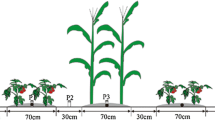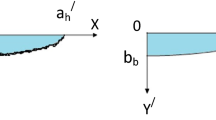Abstract
The size of the free-water ponds under drippers is an important field characteristic of trickle irrigation. Here we review four existing analytical theories that purport to describe 3-D infiltration. We show how they can be used to predict the extent of the pond from basic soil parameters, and the dripper discharge rate. Via a numerical example it is shown that the different theories give significantly different free-water pond radii, especially for high drip discharge rates when the flow is dominated by gravity. We then describe field experiments that were carried out to permit a comparison of the measured and predicted values using independently-measured soil parameters. This test of the different theories was conducted on a loamy soil. Raats' (1971) solution gave the best estimates of the free-water pond radius, across the range of discharge rates. The free-water pond radius, a determinant of the lateral spread away from the dripper, was found to vary only weakly with drip discharge in the range of practical applications. Consequences for management are discussed.
Similar content being viewed by others
References
Ababou R (1981) Modélisation des transferts hydriques dans le sol en irrigation localisée. Thbse University de Grenoble - INPG
Bresler E (1978) Analysis of trickle irrigation with application to design problems. Irrig Sci 1: 3–7
Clothier BE, White I (1981) Measurement of sorptivity and soil water diffusivity in the field. Soil Sci Soc Am J 45: 241–245
Clothier BE, Scotter DR, Harper ER (985) Three-dimensional infiltration and trickle irrigation. Trans ASAE 28: 497–501
Elrick DE, Reynolds WD (1989) Water flux-components and their measurement. Proceedings Appl Soil Phys Stress Envir, NATO, Islamabad
Green WH, Ampt GA (1911) Studies in soils physics. 1 — The flow of air and water through soils. J Agr Sci 4: 1–24
Lafolie F, Guennelon R, van Genuchten MT (1989) Analysis of water flow under trickle irrigation: I. Theory and numerical solution. Soil Sci Am J 53: 1310–1318
Lockington D, Parlange JY, Surin A (1984) Optimal prediction of the saturation and wetting fronts during trickle irrigation. Soil Sci Am J 48: 488–494
Perroux KM, White I (988) Designs for disc permeameters. Soil Sci Soc Am J 52: 1205–1215
Philip JR (1957) The theory of infiltration: 1. The infiltration equation and its solution. Soil Sci 83: 345–357
Philip JR (1969) Theory of infiltration. Adv Hydrosci 5: 215–296
Philip JR (1985) Steady absorption from spheroidal cavities. Soil Sci Soc Am J 49: 828–830
Philip JR (1968) Linearized unsteady multidimensional infiltration. Water Resour Res 22: 1717–1727
Philip JR (1992) What happens near a quasi-linear point source? Water Resour Res 28: 47–52
Raats PAC (1971) Steady infiltration from point sources, cavities and basins. Soil Sci Soc Amer Proc 35: 689–694
Revol Ph, Clothier BE, Vachaud G, Thony JL (1991) Predicting the field characteristics of drip irrigation. Soil Technology 4: 125–134
Revol Ph (1994) Caractérisation hydrodynamique des sols par infiltration bidimensionnelle axisymétrique et modélisation simplifiée de la micro-irrigation. Thèse de Doctorat, Grenoble University, 221p
Russo D (1984) A geostatistical approach to the trickle irrigation design in a heterogeneous soil. 1. Theory. Water Resour Res 19: 632–642
Scotter DR, Clothier BE, Harper ER (1982) Measuring saturated conductivity and sorptivity using twin rings. Aus J Soil Res 20: 295–304
Shani U, Hanks RJ, Bresler E, Oliveira CAS (1987) Field method for estimating hydraulic conductivity and matric potential-water content relations. Soil Sci Soc Am J 51: 298–302
Vauclin M, Haverkamp R (1985) Solutions quasi-analytiques de l'équation d'absorption de l'eau par les sols non-saturés. II. Problème inverse: détermination de la diffusivité capillaire. Agronomic 5: 607–611
Vauclin M, Elrick DE, Thony J-L, Vachaud G, Revol Ph, Ruelle P (1994) Hydraulic conductivity measurements of the spatial variability of a loamy soil. Soil Technology 7: 181–195
White I, Sully J (1987) Macroscopic and microscopic capillary length and time scales from field infiltration. Water Resour Res 23: 1514–1522
Wooding RA (1968) Steady infiltration from a shallow circular pond. Water Resour Res 4: 1259–1273
Author information
Authors and Affiliations
Rights and permissions
About this article
Cite this article
Revol, P., Clothier, B.E., Kosuth, P. et al. The free-water pond under a trickle source: A field test of existing theories. Irrig Sci 16, 169–173 (1996). https://doi.org/10.1007/BF02338967
Received:
Issue Date:
DOI: https://doi.org/10.1007/BF02338967




